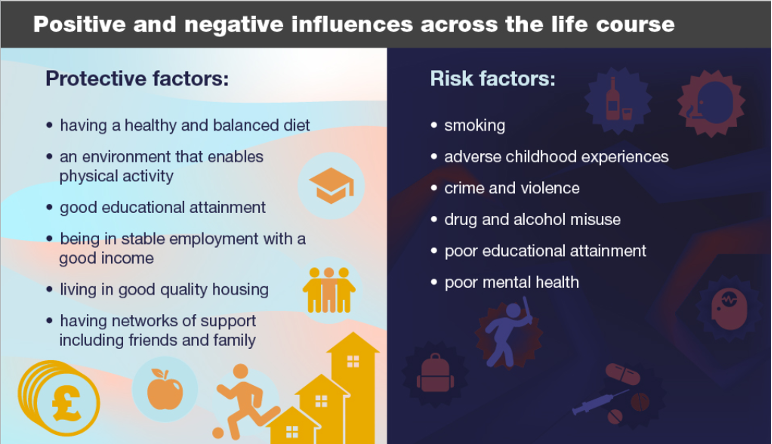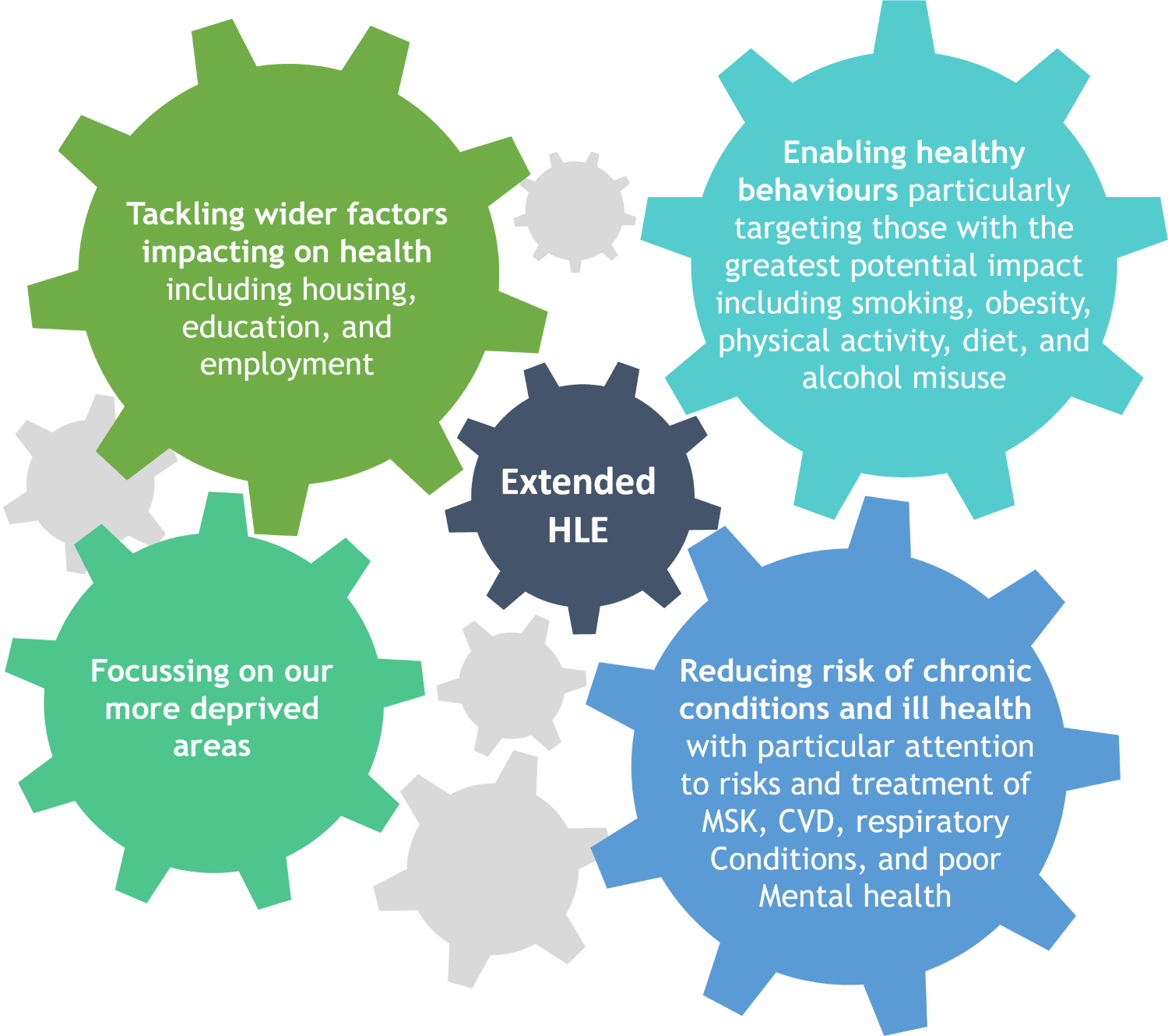Page Contents
Introduction:
The Department of Health and Social Care’s (DHSC) priority to “protect and level up the nation’s health through reducing health disparities” has identified Healthy life expectancy (HLE) as a key outcome measure nationally in assessing the extent to which health is improving and disparities are narrowing.
This briefing outlines what we mean by healthy life expectancy and why it is important; what HLE looks like and what drives HLE nationally and locally; self-reported health status in East Sussex and what impacts on our self-reporting of our general health; best practice to address the HLE gap, and what we are doing about it in East Sussex.
- Life expectancy is the average number of years from birth someone would be expected to live
- Healthy life expectancy is the average number of years from birth someone would be expected to live in a state of good general health.
This report focuses specifically on healthy life expectancy: how long someone is expected to life in good health.
Why is Healthy Life Expectancy (HLE) important?
HLE has been identified as a key outcome measure in assessing the extent to which health is improving and disparities are narrowing across our population.[Endnote 1] HLE divides our expected lifespan into time spent in different states of health or disability.[Endnote 2] This is important because the duration of the period of ill health near the end of life has significant personal and societal implications, including poorer quality of life, poorer health outcomes, more frequent hospital admissions and higher risk for premature mortality.[Endnote 3],[Endnote 4],[Endnote 5]
Across our lives there is systematic variation in both protective and risk factors of health which lead to differing trajectories and outcomes over the course of a person’s life. This in turn impacts on our life expectancy and healthy life expectancy. [Endnote 6] A person’s physical and mental health and wellbeing are influenced throughout life by social, economic, environmental and behavioural risk factors (wider determinants of health) which often cluster in the population.[Endnote 6]Those more impacted by the negative influences of health, are more likely to have shorter life expectancy and more years living with disability.[Endnote 6]
These health inequalities are driven by a variety of risk factors such as smoking rates, access to and quality of health and care, housing quality and living environment.[Endnote 7]
Source: UKHSA (UK Health Security Agency), 2019
Inequalities affecting the life course trajectory can be reduced for the whole population and future generations by altering policies, environments, and societal norms. To extend healthy life expectancy and reduce the gap between those with the longest and shortest estimated healthy life span, key opportunities need to be identified to minimise risk factors and enhance protective factors through evidence-based interventions at key life stages.[Endnote 6]
Summary:
- Improvements in healthy life expectancy in East Sussex are stalling
- Female healthy life expectancy in East Sussex is 63.3 years
- Male healthy life expectancy in East Sussex is 63.1 years
- The gap between areas with the highest and lowest healthy life expectancy in East Sussex is nearly 20 years.
- Those in more deprived areas report poorer health
Key Findings:
- HLE is flat lining: Improvements in health life expectancy are stalling
- Circa 20 year HLE gap: There is a gap of nearly 20 years in healthy life expectancy for both men and women between the most and least deprived areas
- County variation in HLE: Healthy life expectancy is highest in Frant and Groombridge and lowest in Central St Leonards and Hollington
- Health-deprivation link: Those in more deprived areas live more of their lives in poorer health
- Self-reported health varies by ward:Twice as many people report they are in poor health In Hastings compared to Wealden
- Improve self-reported health to improve HLE: changes in self-reported good health prevalence have a larger impact on HLE than changes in mortality rates
- Chronic conditions and multimorbidity reduce HLE: chronic health conditions and multimorbidity are the clearest drivers reducing healthy life expectancy. These include conditions of the musculoskeletal system, the heart and circulatory system and the nervous system (mental health conditions, brain conditions and pain) including dementia, as well as mental disorders, respiratory conditions, and lung cancer.
- Behavioural factors are associated with reduced HLE: Key behavioural factors associated with low healthy life expectancy include smoking, obesity, physical inactivity, alcohol misuse, and diet.
- Wider determinants also impact on HLE: Wider factors impacting on low healthy life expectancy include socio-economic position, employment and economic activity, disability and health conditions and educational attainment
We can extend years lived in good health by enabling healthy behaviours and reducing risk and impact of chronic disease and ill-health.
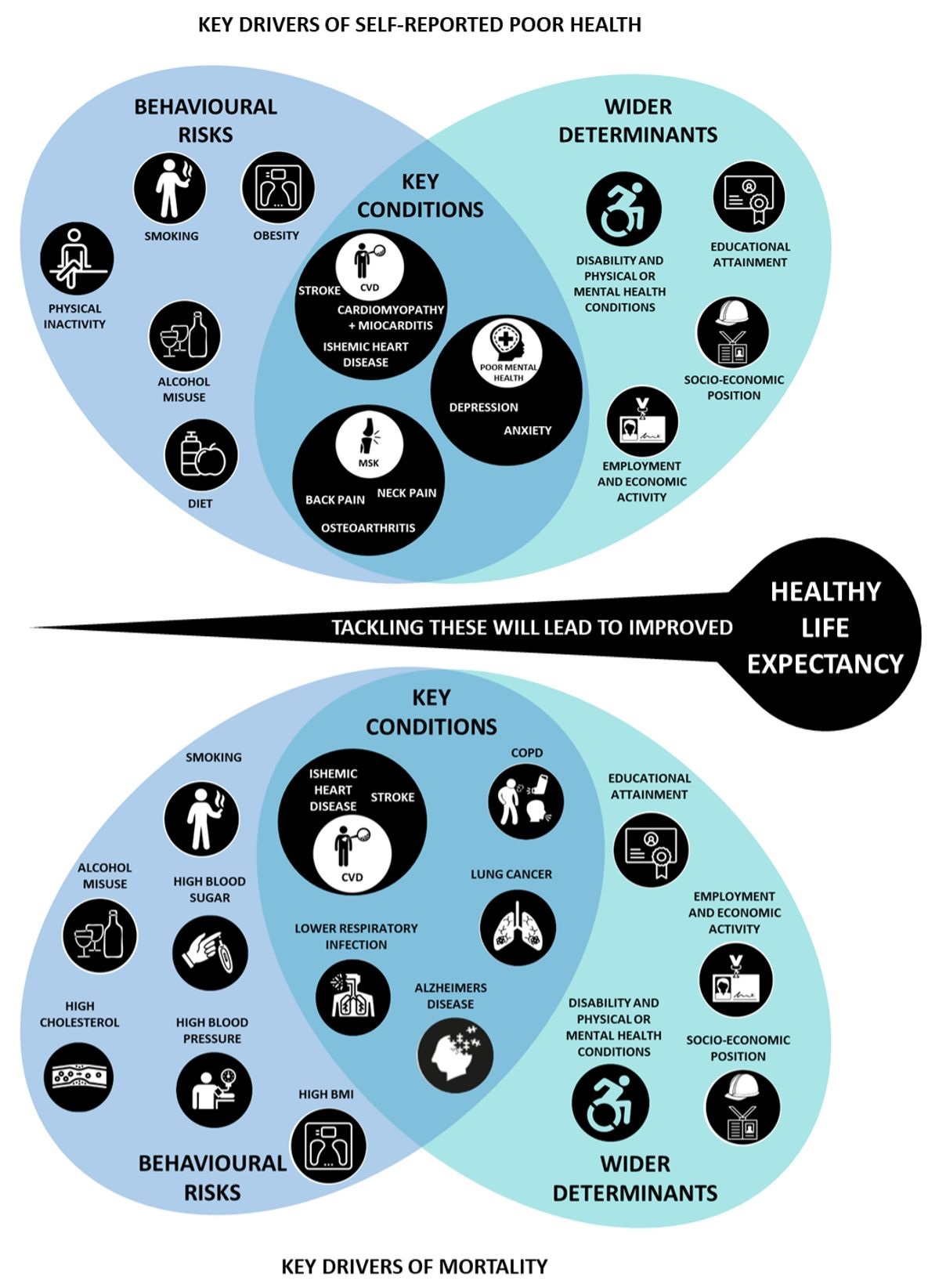
Recommendations
We can extend the years people live in good health in East Sussex by:
- Tackling wider factors impacting on health, including housing, education, and employment
- Enabling healthy behaviours, particularly targeting those with the greatest potential impact including smoking, obesity, physical activity, diet, and alcohol misuse
- Focusing on our deprived areas
- Reducing risk of chronic conditions and ill health, with particular attention to risks and treatment of MSK, CVD, respiratory conditions, and poor mental health
What is Healthy Life expectancy and how is it measured:
Healthy life expectancy (HLE) as a measure adds a quality of life dimension to LE estimates (how long a person is expected to live):
Healthy life expectancy at birth is an estimate of the average number of years babies born this year would live in a state of ‘good’ general health if [current] mortality levels at each age, and the level of good health at each age, remain constant in the future.
OHID (2023) Understanding the drivers of healthy life expectancy
Data on self-reported health status from large surveys, such as the Census, is combined with mid-year population estimates and age-specific mortality rates to produce estimates of the span of life that a person can expect to live in “very good” or “good” health (HLE). This calculation is used to estimate the prevalence of good health and mortality among those living in an area at a specific time period, assuming that a person’s mortality risk at each age throughout their life will remain the same as the current population in each age group. This also allows us to estimate the average number of years lived in poor health, by taking away the average years lived in good health (HLE) from the average life expectancy (LE) for an area.
While we have robust local data on self-reported health status from the 2021 Census, it needs to be noted that this data is only available every ten years. The fact the information is not timely will have important policy implications for actions to improve HLE.
How are we doing in East Sussex:
In the latest published time period (2018-2020) HLE for males in East Sussex is the same as for England (63.1 years), while HLE for females (63.3) is slightly below the national (63.9) However, female HLE has increased from a drop in 2017-19 which was the lowest it had been for 10 years.
A more, up-to-date (2020-2022) HLE has been calculated locally using Census 2021 data, as well as for East Sussex districts and boroughs. Please note that due to differences in data sources and methodology, these locally calculated HLEs cannot be compared to national figures or historical trend data.
Healthy Life Expectancy at birth in East Sussex – 2009/11 to 2018/20, males and females
NB: note axis starts at 60
For both males and females HLE is highest in Wealden and lowest in Hastings. The gap between these areas is 8.8 years for males and 8.1 years for females.
Healthy Life Expectancy at birth for males in East Sussex – 2020 to 2022 (local calculation using Census 2021 general health data)
Healthy Life Expectancy at birth for females in East Sussex – 2020 to 2022 (local calculation using Census 2021 general health data)
Healthy Life Expectancy at birth – 2009 to 2013 – East Sussex MSOA
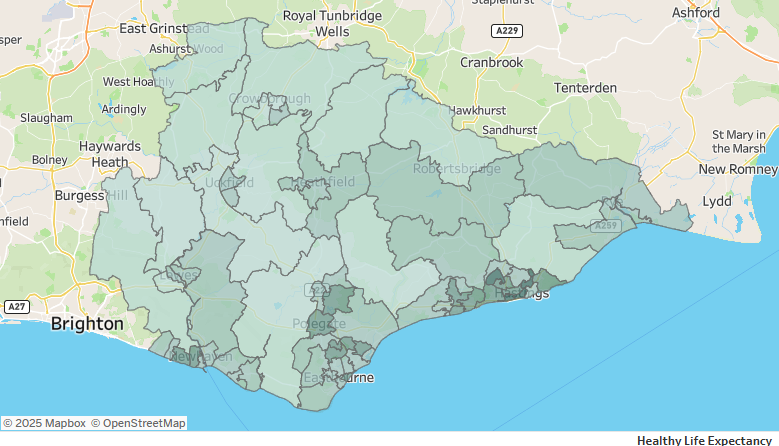
View the East Sussex Healthy Life Expectancy Dashboard – escc.gov.uk
| LA (highest) | Highest HLE | LA (lowest) | Lowest HLE | |
|---|---|---|---|---|
| Wealden | Frant & Groombridge (73.3) | Hastings | Broomgrove (53.9) | |
| Wealden | Forest Row & Coleman’s Hatch (72.9) | Hastings | Central St Leonards (53.9) | |
| Lewes | Wivelsfield Green, Ditchling & Rodmell (72) | Hastings | Hollington (53.9) | |
| Wealden | Buxted, Framfield & Rotherfield (71) | Hastings | Central Hastings (56.7) | |
| Wealden | Mayfield & Wadhurst (70.9) | Eastbourne | Pier (57.0) | |
| Wealden | Five Ash Down, Horsted & Chiddingly (69.8) | Rother | Bexhill Central (57.4) | |
| Wealden | Crowborough North East (69.8) | Hastings | Braybrooke & Bohemia (58.1) | |
| Wealden | Herstmonceux & Ninfield (69.7) | Eastbourne | Langney West (60.2) | |
| Wealden | Chelwood & Nutley (69.7) | Rother | Bexhill North & Sidley (60.4) | |
| Lewes | Chailey, Newick & Barcombe (68.7) | Lewes | Newhaven West (60.6) | |
| LA (highest) | Highest HLE | LA (lowest) | Lowest HLE |
|---|---|---|---|
| Wealden | Frant & Groombridge (74.7) | Hastings | Central St Leonards (55.5) |
| Lewes | Wivelsfield Green, Ditchling & Rodmell (74.2) | Hastings | Hollington (55.8) |
| Wealden | Crowborough North East (73.9) | Hastings | Broomgrove (56.2) |
| Wealden | Mayfield & Wadhurst (73.7) | Hastings | Central Hastings (59.5) |
| Wealden | Forest Row & Coleman’s Hatch (72.9) | Hastings | Braybrooke & Bohemia (60.1) |
| Wealden | Buxted, Framfield & Rotherfield (72.6) | Rother | Bexhill North & Sidley (60.2) |
| Wealden | Crowborough Whitehill & Warren (71.6) | Eastbourne | Langney West (61.0) |
| Rother | Robertsbridge, Hurst Green & Ticehurst (71.4) | Rother | Bexhill Central (61.2) |
| Lewes | Chailey, Newick & Barcombe (71.2) | Eastbourne | Hampden Park North (61.3) |
| Wealden | Chelwood & Nutley (70.9) | Hastings | Ore (61.4) |
At a small area level (MSOA) there is a 19.4 year difference between the MSOA with the highest and the MSOA with the lowest HLE. For females this difference is 19.2 years. For both males (73.3) and females (74.7) HLE is highest in Frant and Groombridge and lowest in Central St Leonards (53.9 years for males and 55.5 for females), as well as in Hollington for males (53.9)
Areas with the lowest and highest Healthy Life Expectancy (2009-2013) and Life Expectancy in those areas (2016-2020) – East Sussex MSOA
There are inequalities across East Sussex in terms of how long people are living, and how much of their life they are living in good health.

On average, a woman living in Central St Leonards will have experienced nearly 11 years in poor health by the time they retire.

This compares to the average woman living in Frant and Groombridge living nearly 9 years of their retirement in good health.
Healthy Life Expectancy by deprivation
On average, people living in the most deprived communities in England have over 18 years less of their lives in good general health than those living in the least deprived areas. In East Sussex, this gap is 14.9 years for males between the most and least deprived quintiles[Footnote 1], and 13.4 years for females.
Healthy life expectancy in East Sussex has increased from 2011 to 2021 in males across all deprivation quintiles. For females, healthy life expectancy in 3 out of 5 quintiles (including the most and least deprived areas) has slightly decreased in 2021. Also, for the first time, in 2021 healthy life expectancy for those in the least deprived areas was higher in males than females.
Healthy Life Expectancy by deprivation quintile – males 2011 and 2021
Healthy Life Expectancy by deprivation quintile – females 2011 and 2021
What affects our healthy life expectancy:
In June 2023, the Office for Health Improvement and Disparities (OHID) published a report Understanding the drivers of healthy life expectancy looking at the key drivers of HLE in the UK to inform work towards their priority to improve HLE nationally. Key findings from the report include that:
- changes in self-reported good health prevalence have a larger impact on HLE than changes in mortality rates:
- if self-reported health prevalence remained constant but mortality rates improved by 2% from 2017 to 2019 levels, HLE would increase by 1 years
- if mortality rates remained constant but self-reported health prevalence improved by 2% in all age-groups, HLE would increase by 1.3 years
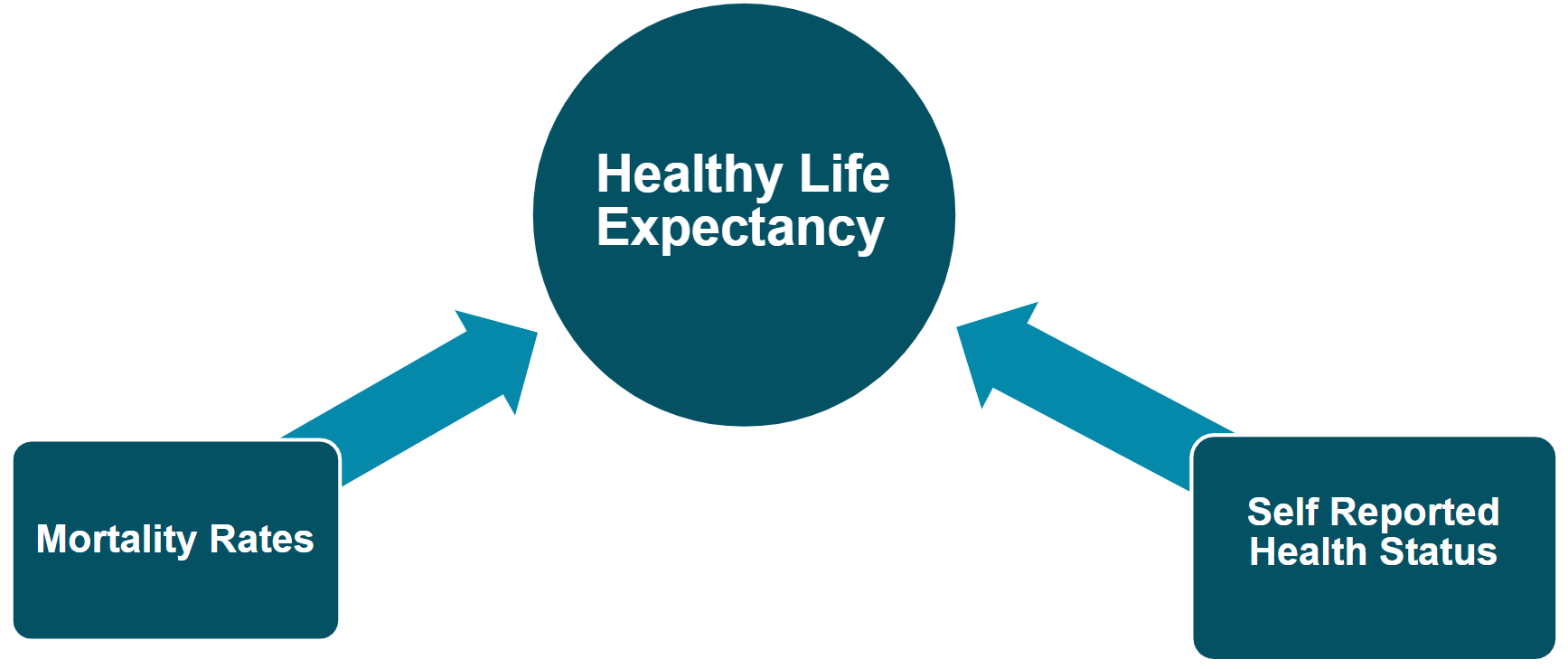
Analysis of mortality rates between 2011-2013 and 2017-2019 show that improving mortality rates contributed to improved HLE. However, throughout this time period for females, and between 2014-2016 and 2017-2019 for males, worsening of self-reported good health prevalence offset these improvements and led to overall worsening of HLE. The OHID report research looked at the drivers of both self-reported health status and mortality rates to help identify how HLE may be improved.
The next section will look in more detail at key factors affecting HLE, outlining what HLE looks like in East Sussex and what is driving it.


